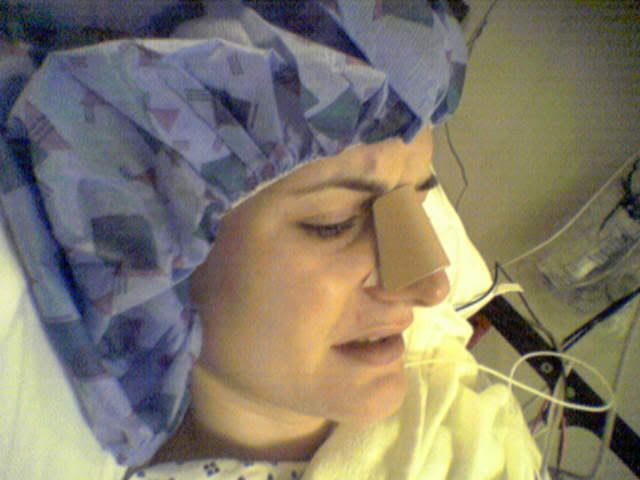People, my people, this is so worth the read.
If you want to learn about chemistry, about science, about brains, about ME JOHANNA, please read this and try to absorb it. It is such a Long but worthwhile Time.com article about "When Worry Hijacks the Brain."
Even the most stable brain operates just a millimeter from madness. In such a finely tuned cognitive engine, only a small part must start to sputter before the whole machine comes crashing down. When that happens, reason and function come undone, rarely as dramatically as in the neurochemical storm that is obsessive-compulsive disorder.
Say you leave work at 6 p.m. for what should be a 12-minute drive home. Say just as you're pulling onto the street, a child on a bicycle crosses in front of you. A few feet later, you feel the thump of a pothole. But what if it wasn't a pothole? Suppose you hit the child.
You look in your rearview mirror, and all is clear, but can you be sure? So you circle back around the block. Still clear--except for a lumpy bag of leaves on the curb. But is it a bag or a child? So you circle once more. Four hours later, you finally arrive home, mutter something to your spouse about a late meeting and go to bed spent and ashamed. Tomorrow you'll do it all over again.
Devoting an entire evening to a 12-minute drive is not the only way to know you've got obsessive-compulsive disorder (OCD). You know it when you shrink from the sight of a kitchen knife, worried that you'll inexplicably snatch it up and hurt yourself or a family member. You know it when leaving the house consumes hours of your day because the pillows on your bed must be placed just right. You know it when you can't leave the house at all for fear of a vast and vague contamination that you can't even name.
We all think we know what OCD is, and most of the time we're all wrong. It's the nervous guy from Monk; it's cranky Jack Nicholson in As Good As It Gets. In the end, though, things usually work out for them. They even get the girl, who sees them as a kind of adorable emotional fixer-upper.
But OCD isn't adorable. [Ed. Note: In the words of one Billy E. Crystal, "It's not funny, it's not fun."]
About 7 million adults, teens and children in the U.S. are now thought to have it in one form or another, and their pain is far worse than you probably know. What's more, since one family member disabled by the disorder can destabilize an entire household, a single diagnosed case can mean several collateral victims. Worse, OCD is a condition that often masquerades as other things. It is routinely labeled depression, bipolar disorder, attention-deficit/hyperactivity disorder (ADHD), autism, even schizophrenia. Victims often conceal their problem for years, ensuring that no diagnosis--right or wrong--can begin to be made.
With the twin obstacles of secrecy and mislabeling, the average lag time between the onset of the disorder and a proper diagnosis is now a shocking nine years, according to surveys of doctors conducted by the Obsessive Compulsive Foundation, a 21-year-old organization with headquarters in New Haven, Conn. It takes an average of eight additional years before effective treatment is prescribed.
If the disorder strikes a young person, as it often does, that can mean an entire childhood lost to illness. "OCD has had a slow research start," says Gerald Nestadt, co-director of the OCD clinic at Johns Hopkins University. "It's behind schizophrenia, bipolar disorder, autism and ADHD."
But all that is changing. A burst of new genetics studies is turning up insights into the causes of the disorder. Scanning technologies are pinpointing the parts of the brain that trigger the symptoms. New treatments are being developed. And refinements of old treatments, like talk and behavioral therapy, are proving more effective than ever.
"Everyone has intrusive thoughts, but most people consider them meaningless and can move on with their lives," says psychologist Sabine Wilhelm, associate professor at the Harvard Medical School and director of the OCD clinic at Massachusetts General Hospital. "For people with OCD, the thoughts become their lives. We can give those lives back to them."
THE ROOTS OF OBSESSION, on the whole, a little anxiety is a good thing. It was not enough for humans in the state of nature to know there was no lion near the family cave; they also had to be able to imagine all the other places a lion could lurk. The same is true for other eccentricities of human behavior. Our anxiety about all the ways harm may befall someone else keeps us mindful of the safety of family and community. "There's a creative, what-if quality to this thinking," says clinical psychologist Jonathan Grayson of the Anxiety and Agoraphobia Treatment Center in Bala Cynwyd, Pa. "It's evolutionarily valuable."Something woven so tightly into the genome is not likely to be shaken loose by a few thousand years of modern living. But that doesn't mean every person with eccentric traits--the woman in the office next to yours who keeps her desk impeccably neat and gets edgy if something is moved out of place, for example--has OCD. "Having these OCD-like traits is a universal experience," says Judith Rapoport, author of the landmark book The Boy Who Couldn't Stop Washing and chief of child psychiatry at the National Institute of Mental Health. "I sometimes count on my fingers when I have nothing to count." The key to diagnosing whether such behavior is authentic OCD is how great an impact the behavior has on your life. "You have to show longstanding interference with function, and that eliminates most people," Rapoport explains.
What causes some people to suffer that interference and most not? Why does their internal alarm keep shouting "Lion!" long after they've checked every place a lion could plausibly be? The answer has always been thought to lie principally in a small, almond-shaped structure in the brain called the amygdala--
--the place where danger is processed and evaluated. It stands to reason that if this risk center is overactive, it would keep on alerting you to peril even after you've attended to the problem.
As it turns out, the amygdala is indeed a big player in the pathological process of OCD but only one of several players. Functional magnetic resonance imaging (fMRI) and other scanning technologies have allowed researchers to peer deeper than ever into the OCD-tossed brain. In addition to the amygdala, there are three other anatomical hot spots involved in the disorder: the orbital frontal cortex, the caudate nucleus and the thalamus--the first two seated high in the brain, the third lying deeper within.
"Those areas are linked along a circuit," says Dr. Sanjaya Saxena, director of the OCD program at the University of California at San Diego. It's the job of that wiring to regulate your response to the stimuli around you, including how anxious you are in the face of threatening or frustrating things. "That circuit," says Saxena, "is abnormally active in people with OCD."
Saxena, who has conducted extensive scanning research, has even come to recognize the neural fingerprint that distinguishes one less common type of OCD behavior--hoarding--from better-known ones. Hoarders who live alone have been known to crowd themselves into small areas of their home, with clear paths left from sofa to kitchen to bathroom, and the rest piled high with debris. When Saxena scanned the brains of these highly particular people, he found that they had equally particular abnormalities. Instead of hyperactivity in any area, they had reduced activity in the anterior cingulate gyrus, the part of the brain that helps you focus your attention and make decisions. "Those are things that compulsive hoarders have a lot of trouble with," he says.
GENES AND GERMS
Although scans can tell you the landscape of the obsessive-compulsive brain, they can't tell you how it got to be that way. As with many other psychological disorders, research is revealing that OCD has a powerful genetic component. Having any blood relative with OCD puts your risk of the disorder at 12%, and while that seems low, it's still more than four times as high as that of the U.S. population as a whole.
If the disorder comes to you through the genes, the next job is to determine which ones. A team of investigators at Johns Hopkins University last summer discovered half a dozen areas in the human genome that appear to be linked to the development of OCD. Analyzing 1,008 blood samples from 219 families in which at least two siblings had the disorder, they discovered gene markers at six sites on five chromosomes that appear more frequently in those kids than in family members and other people without OCD. That study did not tease out how those genes do their damage, but another group has identified a seventh gene whose mechanism is clearer.
Located on the ninth chromosome, that gene--discovered in two studies by researchers at several universities including the University of Michigan and the University of Toronto--appears to regulate a brain chemical known as glutamate. One of a number of substances that stimulate signaling among neurons, glutamate works fine unless you've got too much on hand. Then the signals just keep coming. In the case of the alarm centers in the brain, that means the warning bell just keeps on ringing.
"Glutamate has to be taken up quickly because otherwise it becomes toxic to the brain cells," says Vladimir Coric, director of OCD research at Yale University and a leader in studies of the chemical.
What makes the glutamate-related gene especially suspect is the particular people it affects the most. OCD strikes males and females about evenly, but early-onset forms tend to target boys more than girls. This is particularly true in cases in which the boys also exhibit the involuntary tics or vocalizations often associated with Tourette's syndrome. Interacting with the glutamate gene are three genes related to androgens, or masculinizing hormones. Interacting with those is another gene that has been implicated in Tourette's. Gather all these together in the same chromosomal neighborhood, and they can make trouble. "Kids who start early tend to be boys, tend to have tic disorders and, in genetic analyses, tend to have parents with tic disorders too," says John March, chief of child psychiatry at Duke University.
Other compelling, if controversial, research has long pursued an entirely different cause of OCD: streptococcal infection [Ed. Note: I have been repeatedly diagnosed with this]. As long ago as the 17th century, British physician Thomas Sydenham first noticed a link between childhood strep and the later onset of a tic condition that became known as Sydenham's chorea. Modern researchers who saw a link between tics and OCD began wondering if, in some cases, strep might be involved with both.
Last year investigators from the University of Chicago and the University of Washington studied a group of 144 children-- 71% of whom were boys--who had tics or OCD. All the kids, it turned out, were more than twice as likely as others to have had a strep infection in the previous three months. For those with Tourette's symptoms, the strep incidence was a whopping 13 times as great.
The tics and OCD are probably the result of an autoimmune response, in which the body begins attacking its own healthy tissue. Blood tests of kids with strep-related tics and OCD have turned up antibodies hostile to neural tissue, particularly in the brain's caudate nucleus and putamen, regions associated with reinforcement learning. "There certainly seems to be an epidemiological relationship there," says Dr. Cathy Budman, associate professor of psychiatry and neurology at New York University, "but what it means needs to be further investigated."
HOW TO FIX IT
No matter how or when the disorder hits, the first step in striking back is usually comparatively short-term behavioral therapy, using a technique known as exposure and response prevention (ERP), in which OCD sufferers don't try to avoid their particular source of anxiety but actually seek it out. Eventually, emotional nerve endings grow desensitized to the stimulus. The point is to tough it out until that happens. [ED. NOTE: FUCK THAT SHIT I'M NOT EATING NO TACOS OFF A PUBLIC TOILET I DON'T CARE ABOUT YOUR MOTHERFUCKING ERP]
At the Obsessive Compulsive Foundation convention in Atlanta last summer, Grayson, the Pennsylvania-based clinical psychologist, gave those in attendance who had OCD a quick taste of ERP. Inviting the ones in the audience with dirt and germ anxieties to come forward, he instructed them to sit beside him on the ballroom carpet. Then he told them to touch the carpet and bring their fingers to their lips. Left to themselves, most would have refused or, if they went along, would have then found the nearest bathroom and spent long minutes--perhaps long hours--scrubbing. Instead, they sat with Grayson and the anxiety, learning a very early lesson that the pain does subside. Extended ERP treatment involves a graduated series of such exposures, each a bit more challenging than the one before it.
Such tactical jujitsu works for all manner of OCD, though it's not always easy to find a doctor skilled at administering it. Patients obsessed about their sexual orientation, who become intolerably anxious if they so much as notice an attractive member of the same sex, are assigned to do just that: flip through magazines for scantily clad same-sex models. People plagued by what's known as relationship substantiation, who become consumed by inconsequential defects in a partner, are encouraged to seek out those flaws and even exaggerate them in their mind.
Medication helps too. Antidepressants such as Prozac and other selective serotonin reuptake inhibitors (SSRIs) can help dial down the anxiety enough that patients can get started with ERP and, significantly, stay with it. When patients are children, practitioners are more reluctant to prescribe medication, but they are careful not to stay too long with ERP alone if it's not producing results. "The longer a child struggles with an illness, the more impact it's going to have," says Dr. John Piacentini, director of UCLA's child OCD clinic.
Still, there are some people--kids and adults--whose OCD is so acute that more extreme methods are needed, such as hospitalization, more intensive exposure therapy and other medications.
Coric, of Yale, is among the growing group of investigators experimenting with drugs targeting the glutamate problem. The best medication so far, riluzole, was originally developed for Lou Gehrig's disease and works simply by turning down the glutamate spigot, reducing the amount that's available in the brain. In Coric's admittedly small studies and clinical observations, half of about 50 subjects experienced at least a 35% remission, and almost all the rest improved at least a little.
Much more invasively, investigators are looking into deep-brain stimulation (DBS), in which electrodes are implanted in the brain and connected by wires embedded in the skin to a pacemaker-like device in the chest.
Low doses of current can then be applied as needed to calm the turmoil in the regions of the brain that cause OCD. The procedure sounds extreme--and it is--but it's already been used in about 35,000 people worldwide to treat Parkinson's disease, and FDA approval to use DBS for OCD as well is pending. "Many of our OCD patients are able to re-engage in life rather than being stuck at home," says neurosurgeon Ali Rezai of the Cleveland Clinic, who performs DBS surgery for Parkinson's and has researched it for OCD.
For the vast majority of people, the treatment never needs to go so far. OCD, for all the suffering it inflicts, is nothing more than the brain doing something it's supposed to do--warning you of danger--but doing it very badly. Living in the world means living with risks: real ones, imagined ones, exaggerated ones. That's not an easy lesson, but it's a powerful lesson--one that, once learned, can offer a paradoxical state of peace.
Even the most stable brain operates just a millimeter from madness. In such a finely tuned cognitive engine, only a small part must start to sputter before the whole machine comes crashing down. When that happens, reason and function come undone, rarely as dramatically as in the neurochemical storm that is obsessive-compulsive disorder.
---
I hope you read this. I think that, even if you didn't, you need to understand that this is what it boils down to:
OCD, for all the suffering it inflicts, is nothing more than the brain doing something it's supposed to do--warning you of danger--but doing it very badly.
Very badly indeed.















































